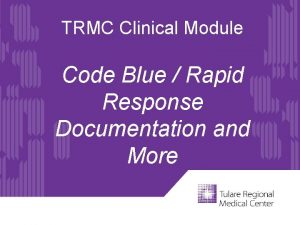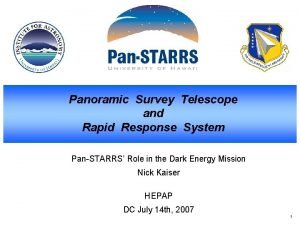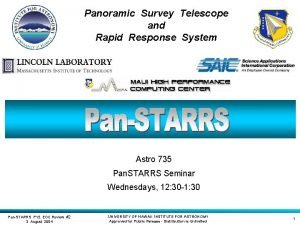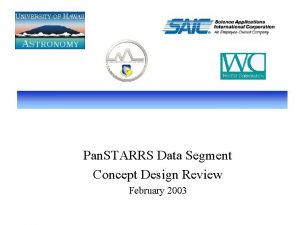Pan STARRS RAPID RESPONSE Rapid Response To what






















- Slides: 22

Pan. STARRS RAPID RESPONSE

Rapid Response… § To what? • By definition something transient § How rapid? • Seconds, minutes, hours, days? § What is the response? • E-mail notification to the world? • How often will/should this happen?

Transient Stationary Objects § § § Supernovae Gamma-Ray Bursters Orphan GRB afterglows Variable Stars Collision course asteroids Items in yellow require Rapid Response

Transient Moving Objects § § High proper motion stars Distant solar companion(s) Distant solar planets Outer Solar System Objects • SDO, KBO, Centaur, J/S/U/N Trojans, Comets § Inner Solar System Objects • MB, NEO, PHO, IEO Items in yellow require Rapid Response

Transient Detection + Combined + + Static - Transient =

Transient Identification Supernovae/GRB Fast Asteroidal Object Normal Asteroidal Object Cometary Object Collision Course Object Slow Asteroidal Object

Fast Asteroidal Objects • highly trailed • nearby NEO/PHO • PSF width • detection method • trailing? • motion? • detection efficiency • confusion w/ galaxies • rapid response? •

Normal Asteroidal Object • slightly trailed • distant asteroid/comet • PSF width • detection method • trailing/non-PSF? • motion? • detection efficiency • confusion w/ galaxies • NOT rapid response

Slow Asteroidal Object • little/no trailing • distant asteroid/comet • PSF profile • detection method • motion • detection efficiency • confusion w/ • galaxies • supernovae • GRB • NOT rapid response

Collision Course Object • little/no trailing • very near object • few X lunar distance • PSF profile X 4 displacement • detection method • parallax • motion • detection efficiency • confusion w/ galaxies • VERY rapid response

Cometary Object • slightly trailed WITH COMA! • highly non-PSF profile • detection method • motion • detection efficiency • confusion w/ galaxies • NOT rapid response

Supernovae/GRB • PSF profile • detection method • motion • confusion w/ • very distant asteroids • SN require rapid response • GRB VERY rapid response

Rapid Response § REQUIRES successive images of same region § RAPID RESPONSE can only be as fast as the time difference between successive frames § GRBs require most rapid response O(minutes) § Collision Course object’s response O(hours)

Supernovae Minutes Collision Course Objects Gamma Ray Bursters Rapid Response Time Frames Hours Days Weeks Months Time between successive images Years

Gamma Ray Bursters Res pon se R False P apid ity ositive s Time between successive images

Moving Object Searches • Successive images assist in identifying / linking moving objects • exposure time should be short enough that not much trailing occurs • successive images should be far enough apart to allow motion detection of slow movers • not so far apart to cause confusion in linkage • existing surveys use 3 images and linear motion of candidates to remove confusion Time between successive images

MB @ Opposition Images § § At opposition ~250 asteroids/deg 2 ~ 2 arc-min between asteroids MB asteroids moving @ ~0. 25 deg/day Require about 4 hours to move 2 arc-min Keep time between successive images < 30 minutes? Shorter is better to reduce confusion. Longer is better to reduce night-to-night linkage confusion.

KBO @ Opposition Images § KBO rates are ~ 0. 02 deg/day § require ~ 12 minutes to move by PSF § To reduce confusion of GRB with KBO Keep time between successive images >15 minutes? Longer is better to reduce confusion.

False GRB rate § Depends on relative fraction of very slow moving objects and GRB rate…

Observing / Pipeline Proposal* § To allow Pan. STARRS to be a RAPID RESPONSE system requires successive images in all survey modes § Has no/little impact on other science goals but allows GRB detection and asteroid astrometry/photometry/colors parasitically to other goals *see dwg_sci email from Jedicke/Chambers on 28 May 2003

Observing / Pipeline Proposal* § Whenever possible for all survey modes • Use filter-dependent Base Time Exposure – BTE = min. time to NOT be read-noise dependent • Obtain successive images from co-addition at sky-position dependent intervals – Depends on mean rates of motion of moving objects at the current position *see dwg_sci email from Jedicke/Chambers on 28 May 2003

Observing / Pipeline Proposal* TO ALLOW Pan. STARRS TO BE A RAPID RESPONSE SYSTEM FOR GAMMA RAY BURSTERS § Whenever possible for all survey modes • Use filter-dependent Base Time Exposure – BTE = min. time to NOT be read-noise dependent • Obtain successive images from co-addition at sky-position dependent intervals – Depends on mean rates of motion of moving objects at the current position *see dwg_sci email from Jedicke/Chambers on 28 May 2003
 Ringo starrs riktiga namn
Ringo starrs riktiga namn Vhf kurs
Vhf kurs Code blue recorder sheet
Code blue recorder sheet Panoramic survey telescope and rapid response system
Panoramic survey telescope and rapid response system Panoramic survey telescope and rapid response system
Panoramic survey telescope and rapid response system Pediatric rapid response team
Pediatric rapid response team Surge and rapid response team salary
Surge and rapid response team salary Natural and forced response
Natural and forced response Natural response circuit
Natural response circuit Primary immune response and secondary immune response
Primary immune response and secondary immune response Tumblr peter pan disneyland
Tumblr peter pan disneyland Meaning
Meaning Ejercicios de prefijos resueltos
Ejercicios de prefijos resueltos Ibb pan
Ibb pan Mam kochać jak pan jezus
Mam kochać jak pan jezus Brilpan
Brilpan Pop rivets types
Pop rivets types Pan tanı kriterleri
Pan tanı kriterleri Apa yang dimaksud dengan pan nasionalisme
Apa yang dimaksud dengan pan nasionalisme Ubiór tadeusza soplicy
Ubiór tadeusza soplicy Pan objetivos
Pan objetivos Podivný případ dr. jekylla a pana hyda rozbor
Podivný případ dr. jekylla a pana hyda rozbor Pan chas
Pan chas











































